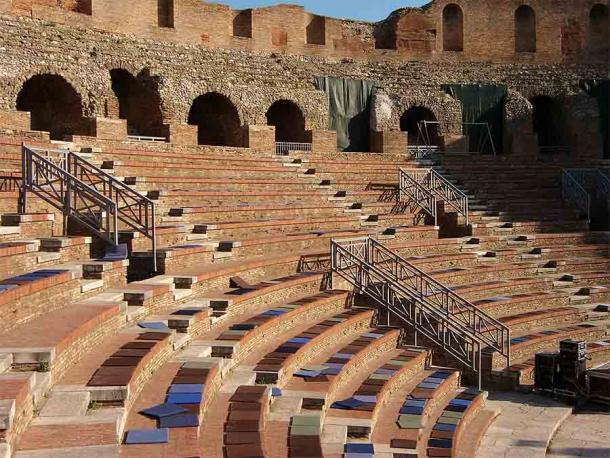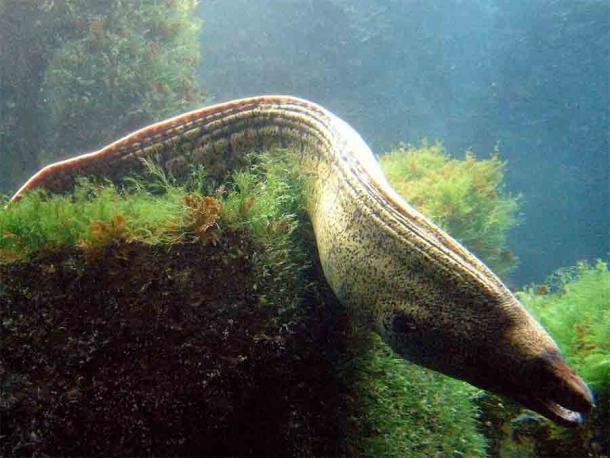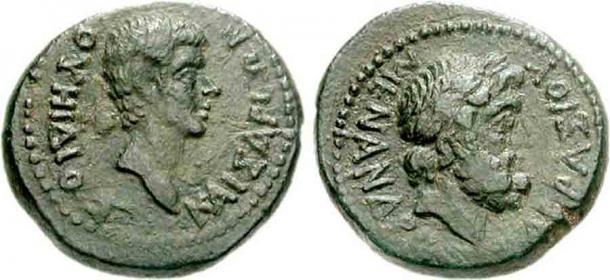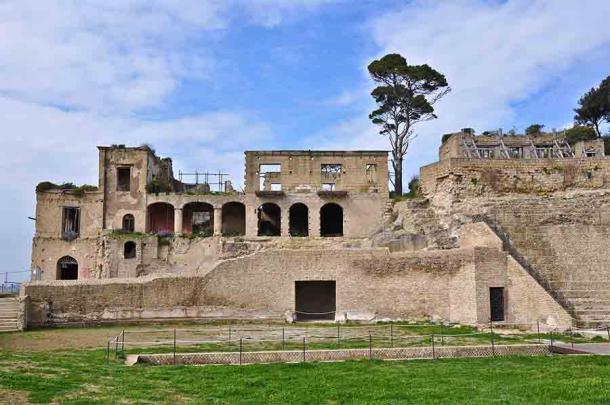
Eaten Alive By Eels: The Infamous Cruelty of Publius Vedius Pollio
Cruel masters were somewhat of a staple in history. Through all the ages, particularly evil men were a dime a dozen and often used their positions of power to exert cruelty on undeserving servants. Sadly, slavery was present throughout history, and Roman history is certainly no exception. Publius Vedius Pollio, a Roman upper-class politician, was noted in those ancient times for his barbaric cruelty towards his slaves, and some truly sadistic practices. Publius Vedius Pollio’s treatment of his slaves was so appalling that it even roused an emperor to take action and caused Roman society to amend their views of cruelty to slaves.
Evil Unsurpassed: How Vedius Pollio Rose to Power
It must be truly a sad fact when history remembers you for your cruelty and evil nature. Still, that is exactly the case of this Roman citizen, Vedius Pollio. History does not remember many details about his life though we know that he was born sometime in the 1st century BC, as the son of a freedman (meaning his father was likely a slave before becoming free).
- The Strict Rules Dividing Ancient Roman Social Classes
- Mythbusting Ancient Rome: Cruel and Unusual Punishment
Nevertheless, Vedius Pollio managed to soar high in a true rags to riches tale and nestled himself cozily into the equestrian rank of Rome’s distinguished citizens. The so-called equites were the second in rank of the property-based classes in Rome, surpassed only by the senatorial citizens that held the primary form power and its attendant luxuries and privileges.

The Roman theater in Benevento, Italy, birthplace of Vedius Pollio, probably the cruelest Roman ever. (Simblek at Italian Wikipedia / Public domain)
It is speculated that Pollio was born in the city of Benevento (Latin: Beneventum), situated in modern-day Campania, Italy. This is assumed from the fact that once wealthy and in a high-status position Vedius Pollio erected a caesareum(a temple) in honor of his friend, Emperor Augustus. This he did of his own accord and from his own finances. Of course, this indicates that at this time he was exceedingly rich. Funding the construction of a temple was a major undertaking and investment.
It seems that Vedius Pollio managed to gain the friendship of none other than the emperor of Rome, Augustus. Before the crowning of Octavian Augustus, no sources mention Pollio with certainty, only after the rise of the emperor does Pollio’s name begin to appear in the historical records. Because he was a friend of Augustus he gained certain favor and rose in the ranks more swiftly. In time, he was appointed to an important position of authority in the Roman province of Asia.
This administrative division was a senatorial province and was managed by a proconsul. Whether this was the position held by Pollio is not known. Nevertheless, the fact that a member of the equestrian order was placed in such an important and high position within the province was appalling to many in Rome's upper-class circles. And it is a clear indication that Vedius Pollio was a particularly close friend of the emperor.

The even-now famous Grotta di Seiano grotto complex, near Naples, Italy, was part of the luxurious Pausilypon villa that Vedius Pollio built to show off his wealth. (Diego Menna / CC BY-SA 3.0)
From the Son of a Freed Slave to a Wealthy Slave Owner
Either way, historians presume that Vedius Pollio served his term of office in Asia sometime around 30 BC, before a regular proconsular Roman governor was appointed in his stead. Others propose a theory that he served there after a major earthquake struck the province in 27 BC. Nevertheless, it is clear that he held a lucrative power position and that he managed to become extremely wealthy.
His wealth is indicated by several properties that he owned. One of these was the famed Grotta di Seiano, part of alavish and majestic seaside villa located in Phlegraean Fields (Campi Flagrei), close to Naples, Italy. This marvel of Roman architecture was definitely a luxury for a member of the equestrian order to own.
The sprawling private luxury villa, known as Pausilypon, was certainly a sign of immense wealth. Perched on a wave-battered cliff, the luxurious mansion had its own small amphitheater for gladiatorial fights, and the above mentioned 842-yard (770-meter) long grotto that connected the villa to the city of Pozzuoli.
The grotto part of the complex was designed by the famed Roman architect, Cocceius Auctus, who also designed other famous grotto structures during the reign of Augustus. Later, the celebrated Roman poet, Ovid, described the villa of Pausilypon to be “like a city.”
- Mad, Bad, and Deadly: Power in the Hands of Infamous Roman Emperors
- The Search Is On For Caligula’s Orgy Boats Where His Twisted Fantasies May Have Been Played Out
Still, Vedius Pollio’s wealth and his friendship to the emperor were not the things for which he was remembered. It was his extreme cruelty that made him “infamous.” He was incredibly cruel towards his slaves, of which he owned a great many. He had an evil habit of throwing his unfortunate slaves alive into a great pool of moray eels that he kept for just that purpose. These eels would rip a man to pieces in a matter of minutes. It was a particularly torturous way to die.
It is important to note that by killing his slaves in this way, Vedius Pollio broke no Roman law. Writing of Pollio’s habits, Seneca says: “cum in servum omnia liceant” (“all things are allowed to be done to a slave”) .
However, Pollio’s cruelty was viewed by Roman society as particularly evil, ignoble, and scandalous. As such, Vedius Pollio was the talk of Roman society at the time, and many mentions of his actions exist in surviving letters and writings.
Furthermore, Seneca describes the event from a moral point of view, saying: “Slaves are allowed to run and take sanctuary at the statue of a god; though the laws allow a slave to be ill-treated to any extent, there are nevertheless some things which the common laws of life forbid us to do to a human being.”

Vedius Pollio was especially infamous in his lifetime for the cruel use of moray eels with his slaves and others that incurred his displeasure. (Drow male / CC BY-SA 4.0)
How Vedius Pollio Was Finally Judged By The Emperor No Less!
His cruel practices surfaced during a visit from his personal friend, Emperor Augustus. The anecdote became all the talk in society and brought an end to Pollio’s cruel treatment of slaves. It happened when Augustus came to a formal dinner at Vedius’ sprawling luxury villa.
At one point during the evening, a servant accidentally dropped and broke a crystal glass. Enraged, Vedius Pollio ordered him seized at once and immediately thrown into the infamous pool of moray eels. Well aware of how barbarous and painful such a death is, the slave at once ran to the emperor and dropped to his knees. He begged not for his freedom, but only to be killed in a less painful fashion.
Augustus was appalled. He had heard rumors of Pollio’s cruelty but seeing it firsthand was horrifying. At once he ordered that the pool of eels be filled in, and that every single crystal dish in Pollio’s villa be smashed before his eyes.
The slave was not punished for his absurd “transgression.” Instead, Augustus had him freed. Vedius Pollio did not object: he accepted the emperor’s wrath stoically. It is possible that this event happened later in Pollio’s life. Either way, he seemingly respected his friend Augustus, and wholly accepted his punishment and the imperial reprimand. Whether or not he stopped with his cruel behavior is not known, but we do know that afterwards he bequeathed one of his luxury villas in Rome to the emperor himself. Augustus had it demolished immediately. In its place, he raised a colonnade, known as the Porticus of Livia, which he dedicated to his own wife, Livia Drusilla.
Needless to say, the scandalous behavior of Vedius Pollio was all the buzz across the Roman Empire. Numerous high-class individuals of the time made comments on these barbarous events and the cruel treatment of slaves. It seems that the scandal created important questions of morality and ethics, causing many to touch upon the question of slave abuse.
Cicero, that famed Roman who needs no introduction, mentioned Pollio in one of his surviving letters. At the time, Cicero was the governor of the province of Cilicia. On his return to Rome, he stopped at the town of Laodikeia, and from there sent a detailed letter to Atticus. It was casual correspondence and touched upon many subjects and events of that year.

A classic Roman coin from 27 BC-AD 14 showing Vedius Pollio on one side (left side) and the head of Zeus (right) on the opposite side. (Classical Numismatic Group, Inc. http://www.cngcoins.com / CC BY-SA 3.0)
The “Magnus Nebulo:” The Great Roman Miscreant
Saving the spiciest gossip for the end, Cicero writes towards the finish of his letter about Vedius Pollio, saying to his pen-pal: “sumus enim ambo belle curiosi,” which translates to “we are both fond of a piece of scandal. “He then mentions “a certain close friend of Gnaius Pompeius, known as Vedius Pollio,” whom Cicero met personally while traveling from Tarsus to Laodikeia. The meeting was seemingly a totally weird affair, with Pollio traveling with an entourage of wild animals and a mob of slaves. Cicero writes that “he had never before seen a more depraved person” (numquam vidi hominem nequiorem), and calls Vedius Pollio a “great miscreant” (magnus nebulo).
In the following decades, the infamy of Vedius Pollio was often mentioned by some of the most famed historians in Rome. Cassius Dio, in one of his numerous works, writes:
“This same year Vedius Pollio died, a man who in general had done nothing deserving of remembrance, as he was sprung from freedmen, belonged to the knights (equites), and had performed no brilliant deeds; but he had become very famous for his wealth and for his cruelty, so that he has even gained a place in history.
Most of the things he did it would be wearisome to relate, but I may mention that he kept in reservoirs huge lampreys that had been trained to eat men, and he was accustomed to throw to them such of his slaves as he desired to put to death.”
From this writing there arose a misconception that Pollio kept lampreys instead of moray eels. This is most likely an error, as the two creatures are somewhat similar in appearance. But the lamprey is a type of parasitic fish, and perhaps not capable of devouring a man. A moray eel on the other hand is an opportunistic, carnivorous predator and can certainly devour a person when in a group, much like piranhas do.
Other writers, such as Pliny the Elder or Seneca the Younger, discussed his cruel practices while focusing on questions of ethics and morality, exploring to what extent a man’s anger can lead him. In his major work, “De Irae” (On Anger), Seneca dissects the evil practice of Pollio, taking a philosophical approach to understanding it.
“To reprove a man when he is angry is to add to his anger by being angry oneself. You should approach him in different ways and in a compliant fashion, unless perchance you be so great a personage that you can quash his anger, as the Emperor Augustus did when he was dining with Vedius Pollio. One of the slaves had broken a crystal goblet of his: Vedius ordered him to be led away to die, and that too in no common fashion: he ordered him to be thrown to feed the muraenae (moray eels), some of which fish, of great size, he kept in a tank. Who would not think that he did this out of luxury? But it was out of cruelty.”

The remains of the luxurious Pausilypon villa where so much cruelty by Vedius Pollio was witnessed, recorded, and remembered. (Armando Mancini / CC BY-SA 2.0)
The Limitless Surge of Human Anger
The later Christian writer, Tertullian, in his work “ De Pallio,” wrote a passionate chapter on the cruelty of Vedius Pollio:
“Equally do I plunge the scalpel into the inhumanity which led Vedius Pollio to expose slaves to fill the bellies of sea eels. Delighted, forsooth, with his novel savagery, he kept land monsters, toothless, clawless, hornless: it was his pleasure to turn perforce into wild beasts his fish, which (of course) were to be forthwith cooked, that in their entrails he himself withal might taste some savour of the bodies of his own slaves.”
- 50 Roman Slaves Found Buried with ‘Care’ in England
- The legendary Spartacus: Gladiator and leader of slaves against the Romans – Part 1
Whether or not Pollio consumed the eels that fed on human flesh is not known. Nevertheless, there are no reasons to dismiss that possibility as untrue. It seems that his cruelty was without measure.
Still, we cannot fathom the reasons for which he did these evil things? Was it the corrupting effect of power and wealth? Or some serious sadistic fault within his psyche? We will never know. Still, if we consider the fact that Vedius Pollio himself was a son of a freed slave, his mistreatment of slaves becomes all the stranger and more malicious.
Top image: A famous painting depicting a slave market in Rome in ancient times. And after the arrival of Vedius Pollio, the slaves of Rome had reason to be afraid because his cruelty was worse than anything they had ever heard of or seen. Source: Gustave Boulanger / Public domain
By Aleksa Vučković
References
Berdowski, P. 2017. Ex Amicis Divi Augusti: P. Vedius Pollio. Palamedes, University of Warsaw.
Parker, J. H. 1883. The Via Sacra: Archeology of Rome. J. Parker.
Pearse, R. 2012. Vedius Pollio and the Lampreys. Roger Pearse. [Online] Available at: https://www.roger-pearse.com/weblog/2012/07/03/vedius-pollio-and-the-lampreys/
Zaragoza, B. 2012. Pausilypon: A Visit to Publius Vedius Pollio’s Villa. Napoli Unplugged. [Online] Available at: https://www.napoliunplugged.com/pausilypon-visit-publius-vedius-pollios-villa.html
















Comments
This waste of a human man was a coward of epic porpotion i’m guessing.
-KLM
makes the old saying, “the worst master is that of a former slave” bring true. There was likely some sort of subconcious revenge motive towards the slaves.